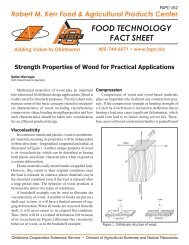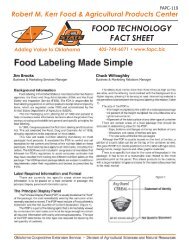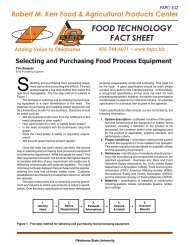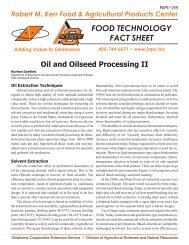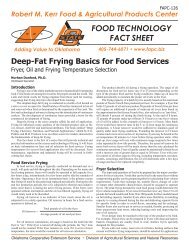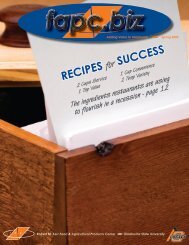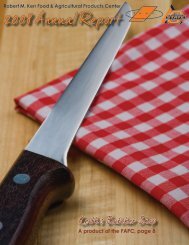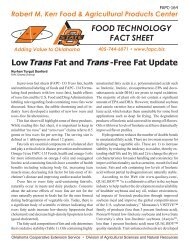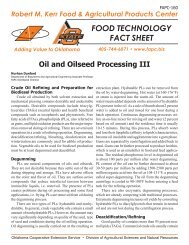Spring/Summer 2010 - Robert M. Kerr Food & Agricultural Products ...
Spring/Summer 2010 - Robert M. Kerr Food & Agricultural Products ...
Spring/Summer 2010 - Robert M. Kerr Food & Agricultural Products ...
Create successful ePaper yourself
Turn your PDF publications into a flip-book with our unique Google optimized e-Paper software.
Preserving food<br />
“An army marches on its<br />
stomach.”<br />
Napoleon<br />
The step our ancestors took from<br />
hunting and gathering food to<br />
cultivating and growing was significant.<br />
However, the accompanying<br />
achievement of being able to preserve<br />
it is equally important.<br />
Prior, one of the tasks near the top<br />
of our ancient ancestors’ daily list was<br />
procuring the next meal. Significant<br />
amounts of time were spent, not only<br />
during the actual hunt, but also preparing<br />
for the next one.<br />
Ancient agriculture and subsequent<br />
preservation techniques would<br />
have broken this cycle and in the process<br />
would have given our forebears<br />
the precious commodity – time.<br />
There would have been more time<br />
to think, to invent, to explore, and to<br />
build. Without methods for storing the<br />
food, they were only slightly better<br />
off than the early hunters, who would<br />
have been stuck in a cycle of hunt, eat,<br />
sleep, hunt, eat, sleep…<br />
It is interesting to note many of<br />
the early techniques worked for preserving<br />
food also worked for preserving<br />
other things.<br />
Archeologists working in Egypt<br />
around 1800s unearthed a large sealed<br />
earthen pot. After breaking the seal,<br />
they looked inside and found a dark,<br />
viscous liquid.<br />
18 | fapc.biz<br />
Curious, they inserted their fingers<br />
and carefully tasted honey. They enjoyed<br />
several handfuls of the ancient<br />
treat before noticing something just<br />
beneath the surface. After carefully<br />
tipping the pot over and pouring out<br />
the remaining honey, they discovered<br />
perfectly preserved human remains.<br />
Not all preservation discoveries<br />
were quite that macabre. During<br />
the Napoleonic Wars (1803-1815),<br />
the French government offered a reward<br />
for an inexpensive and effective<br />
method for preserving large amounts<br />
of food.<br />
Sugar, often used as a preservative,<br />
was in short supply because of<br />
the war, and there was a general desire<br />
to reduce dependence on foreign imports<br />
of food.<br />
Ultimately, the reward would be<br />
claimed by Nicolas Appert, a French<br />
chef who was responsible for developing<br />
the basis of modern canning.<br />
He would place food into specially<br />
designed glass containers (initially<br />
champagne bottles), which were then<br />
sealed and placed into canvas bags.<br />
The bags protected the containers and<br />
captured broken glass. Should any of<br />
the bottles explode during processing,<br />
they were then placed into boiling water<br />
baths.<br />
Glass containers were commonly<br />
used until 1810, when Peter Durand<br />
patented the use of “tinplate canisters”<br />
in Britain.<br />
While these containers would have<br />
roughly resembled the cans we use<br />
today, they were certainly not identical.<br />
Large, bulky, and sealed with lead<br />
solder, they had to be opened with a<br />
hammer and chisel or smashed open<br />
with a rock.<br />
It wasn’t until 1855, the first can<br />
opener was patented by <strong>Robert</strong> Yates<br />
in Britain. Ezra Warner patented the<br />
first can opener in the United States in<br />
1858.<br />
However, the first major demand<br />
for canned food in the United States<br />
didn’t occur until the Civil War in<br />
1861.<br />
Canned foods consumed by Union<br />
and Confederate soldiers included<br />
meat and vegetable stew, pork and<br />
beans, condensed milk, oysters, and<br />
green beans.<br />
While there are many different<br />
methodologies used, all food preservation<br />
techniques share the same basic<br />
goal of providing a safe, stable product,<br />
which can be eaten at a later date.<br />
However, they also have played<br />
a role in the development of human<br />
society.<br />
References:<br />
Pickled, potted, and canned: How the art and science of food preserving changed the world.<br />
2000. Shephard, Sue. Simon and Shuster Paperbacks. New York, NY.<br />
Pickled to perfection. September 1996. Brandt, Laura. <strong>Food</strong> Product Design.<br />
Rediscovering ingredients of antiquity. October <strong>2010</strong>. Pszczola, Donald. <strong>Food</strong> Technology.




